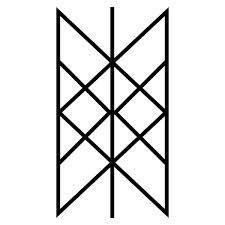What Are the Runes?
What Are the Runes?
My practice is centered around the use of the Runes of the Elder Futhark. The Runes are a set of symbols from about two-thousand years ago in the Germanic regions of Europe, with the oldest known inscriptions dating to about 150 AD – obviously the one who inscribed them had to know them, so there is reason to believe they are far older still. It is believed that they were greatly influenced by the Latin alphabet, and this is substantiated by the fact that the Romans had been the undisputed ruling power of Europe in that time. However, unlike their Latin counterparts, the Runes served another purpose in addition to their use in mundane context, in that they were believed to possess magickal power, power which was expressed in various ways, from divining the future to imbuing certain traits. To the tribes of pre-Christian Europe, the Runes were sacred in their own right.
There are two main “Futhark” (a word derived from the first six Runes): the Younger and the Elder. The Younger has only 16 Runes and dates to the Viking age, whereas the Elder is older, as the name implies, and has 24 Runes. I use the Elder Futhark exclusively, due to the fact that they belong to a rich esoteric tradition and have the most “depth”. While there is a clear historical point of origin for the Runes as referenced above, there is also a mythological one, and despite obvious “factual” inaccuracy, there is a great deal of “truth” present – the ability to understand the difference between these is vital in order to fully appreciate any mythology.
According to myth, the Germanic patriarch Wotan (who will be described in greater detail in another piece, but just imagine a very morbid Gandalf and you’ll get the idea) hung from the world tree, a great yew called Yggdrasil, for nine days and nine nights with a spear in his side. He hung in a death trance, without food or water, and staring down into the roots of Yggdrasil until the glowing forms of the Runes appeared to him. This nine day ordeal is described as sacrificing himself to himself “Wotan to Wotan”, the act of killing the old self in order to make the new – the fact that Yggdrasil itself is a yew tree supports this notion.
There is another element to the Elder Futhark which reinforces my assertion to use it instead of the Younger, and that it the relationship of each Rune of the Elder Futhark with Skuld’s Net, also known as the “Web of Wyrd”. Skuld’s Net is a series of nine lines, three vertical, three slanting left, and three slanting right. The interpretations of this symbol vary, but ultimately it depicts the Norns (those who weave “Wyrd” or “fate”) and that which they weave. The interpretation I use is that the three vertical lines are the Norns – Urd, Verdandi, Skuld – and the diagonal lines are the threads which bind them together.
Urd is the past, “That Which Has Come into Being”, and can be thought of as solid, rigid, earthy – the soil in which Yggdrasil is rooted.
Verdandi is the present, “That Which is Coming into Being”, and unlike many contemporary philosophies which assert that there is only “now”, Verdandi implies that “now” is an illusory point between past and future, one which becomes past as soon as it is observed – the point of weaving.
Last is Skuld, “That Which Should Come into Being” the fluid, watery counterpart to hard Urd, which is yet to be woven and solidified via Verdandi – many potential futures to be woven.
It is from these nine lines that the Runes of the Elder Futhark come, and each of the 24 Runes can be found within. Thus, even the act of communication via writing was somewhat mystical, and if one thinks about it, isn’t writing a fairly esoteric act? A series of abstract lines arranged in order to contain and transmit complex information? “Spelling” indeed!
They had back then the secret ingredients to functional, practical occultism that are very much in short supply today. The extremes of human experience were the norm then, and it wasn't too uncommon to know a few folks with at least a handful of tales to tell of combat and peril. These days those experiences which evoke a certain animal thrill as one's life is on the line are almost non-existent, and life is very sterile, safe, and as such much of we call "magick" fails because it is so very safe.
My practice itself is either using the Runes to discern outcomes or to make Bindrunes. Fact is that regardless how much time progresses, the same themes are present in everything that happens.
Anyone can use tools like Runes and Tarot to help them reflect on a situation, and they are expressions of latent human capabilities for this kind of thing. I'd say it's a particular breed which can utilise magick most,effectively, which will be touched on in the Wotan article.
Hello! In your article you say that runes are something magical, but how do you use them in your practice? Do you think that if you use runes, you have magic? Thx.
An interesting topic. I've heard enough about rune magic. I would like to move to those times for a while, to look at the ancient peoples. Who knows, maybe some kind of magic could exist in those distant times, we cannot know, even statements to the contrary are also suspect.
